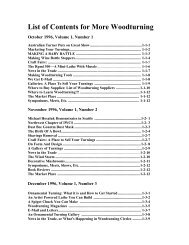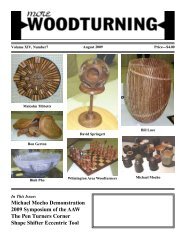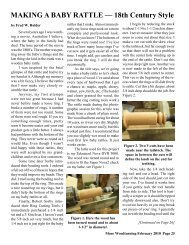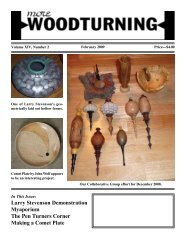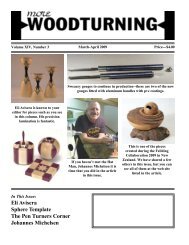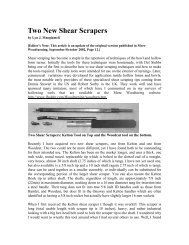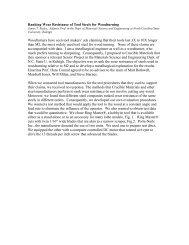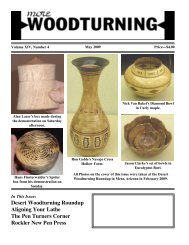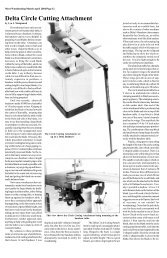Balancing Natural Edge Bowls Questions and Answere The Pen ...
Balancing Natural Edge Bowls Questions and Answere The Pen ...
Balancing Natural Edge Bowls Questions and Answere The Pen ...
You also want an ePaper? Increase the reach of your titles
YUMPU automatically turns print PDFs into web optimized ePapers that Google loves.
Proper Chain Saw File H<strong>and</strong>les Continuedfrom Previous PageWhen making the h<strong>and</strong>les I used such chunks ofwood as were h<strong>and</strong>y. In fact, one could cut a h<strong>and</strong>lesized branch, work it up a bit with a pocket knife, <strong>and</strong>jamb the tang of the file into the center pitch...but thatwould not be woodturning. Instead I used some blanksabout 5” long <strong>and</strong> about 1 1/2” squarish (some were abit more rectangular). AND I wanted a ferrule to assurelong h<strong>and</strong>le life <strong>and</strong> to avoid unsafe splitting outwhen filing.Figure 3. <strong>The</strong> ferrules were cut from old electricalaluminum conduit.<strong>The</strong> ferrules were cut from old electrical aluminumconduit. Figure 3 shows the result. I turned the tenonwith a slight taper, <strong>and</strong> longer than the ferrule, doingtrial fitting <strong>and</strong> carefully reducing tenon diameter untilachieving a snug fit. <strong>The</strong>n I put the file into the top ofmy bench vice, opened just the two opposite edges ofthe ferrule on opposite vice jaws. <strong>The</strong>n I hammeredthe h<strong>and</strong>le into the ferrule for a press fit. At that pointI remounted the h<strong>and</strong>le in the lathe, finished the woodturning,<strong>and</strong> used a parting tool to cut the tenon flushwith the ferrule. A few drops of superglue were addedat both ends of the ferrule where it contacted wood,“just to make sure” of a tight fit.Next came drilling the hole for the tang of thefile. As Figure 4 shows, I chose a drill just under thesize of the widest measure of the tang at 3/4 of the wayfrom the pointed end. In this case a 7/64” drill bit wasappropriate for a 5/32” diameter file. I drilled to a bitover the length of the tang, inserted the tang of the file,stood the file on my workbench, <strong>and</strong> tapped the woodh<strong>and</strong>le with a mallet until a solid “thud” was heard,firmly seating the file.Figure 4. This photo shows the details.I made different numbers of grooves <strong>and</strong> alteredeach h<strong>and</strong>le to be distinct. That way, over time, thefeel of the right file would match up with the correctchain saw.Initially I planned to just woodburn in the nameof the saw <strong>and</strong> the file size. However, I later decided toadd the model number of the saw. That way, when in arush <strong>and</strong> dashing off to the store for a replacement file,that h<strong>and</strong>le would have all the information right there!Figure 5 shows 4 files. I made an extra for the big Husqysince it seems to be used sometimes from the garage,<strong>and</strong> sometimes out of my basement studio.Figure 5. Four files with different h<strong>and</strong>les.Figure 6 is a close-up showing model numbers on2 of the h<strong>and</strong>les. Two of the files, for the Gas Husqy <strong>and</strong>the Ryobi Pruner, are hung on the garage wall so as tobe h<strong>and</strong>y for sharpening. <strong>The</strong> second Gas Husqy file,<strong>and</strong> the Husqy Electric files are in the maintenance boxfor chain saws, kept in my basement studio.When the file h<strong>and</strong>les were all done (<strong>and</strong> I decidedto not bother applying any finish) I turned to my twobowls gouges to apply the “Warren Carpenter AntirollingFlats.” First I set a gouge on the lathe’s bed <strong>and</strong>moved it about to find the balancing point. This turnedMore Woodturning June 2010 Page 16



